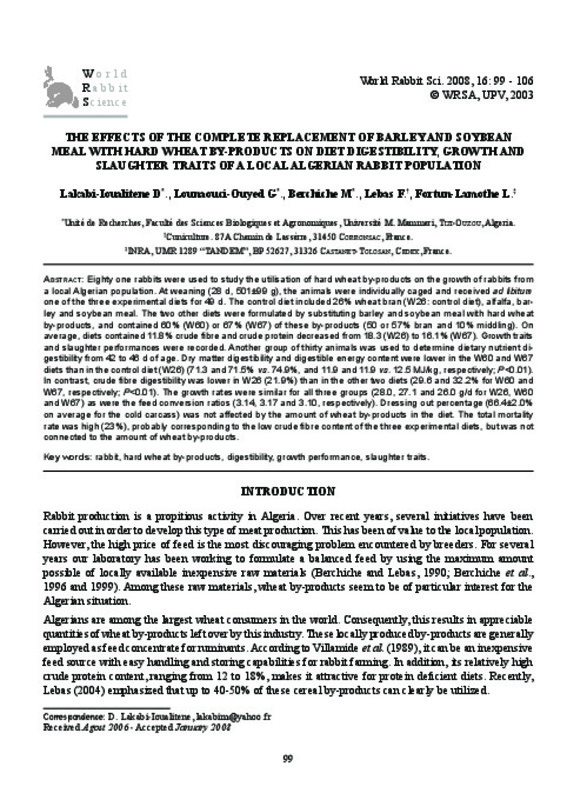JavaScript is disabled for your browser. Some features of this site may not work without it.
Buscar en RiuNet
Listar
Mi cuenta
Estadísticas
Ayuda RiuNet
Admin. UPV
The effects of the complete replacement of barley and soybean meal with hard wheat by-products on diet digestibility, growth and slaughter traits of a local Algerian rabbit population
Mostrar el registro sencillo del ítem
Ficheros en el ítem
| dc.contributor.author | Lakabi-Ioualitene, D.
|
|
| dc.contributor.author | Lounaouci-Ouyed, G.
|
|
| dc.contributor.author | Berchiche, M.
|
|
| dc.contributor.author | Lebas, F.
|
|
| dc.contributor.author | Fortun-Lamothe, L.
|
|
| dc.date.accessioned | 2010-08-02T11:14:06Z | |
| dc.date.available | 2010-08-02T11:14:06Z | |
| dc.date.issued | 2010-08-02 | |
| dc.identifier.issn | 1257-5011 | |
| dc.identifier.uri | http://hdl.handle.net/10251/8520 | |
| dc.description.abstract | [EN] Eighty one rabbits were used to study the utilisation of hard wheat by-products on the growth of rabbits from a local Algerian population. At weaning (28 d, 501±99 g), the animals were individually caged and received ad libitum one of the three experimental diets for 49 d. The control diet included 26% wheat bran (W26: control diet), alfalfa, bar- ley and soybean meal. The two other diets were formulated by substituting barley and soybean meal with hard wheat by-products, and contained 60% (W60) or 67% (W67) of these by-products (50 or 57% bran and 10% middling). On average, diets contained 11.8% crude fibre and crude protein decreased from 18.3 (W26) to 16.1% (W67). Growth traits and slaughter performances were recorded. Another group of thirty animals was used to determine dietary nutrient di- gestibility from 42 to 46 d of age. Dry matter digestibility and digestible energy content were lower in the W60 and W67 diets than in the control diet (W26) (71.3 and 71.5% vs. 74.9%, and 11.9 and 11.9 vs. 12.5 MJ/kg, respectively; P<0.01). In contrast, crude fibre digestibility was lower in W26 (21.9%) than in the other two diets (29.6 and 32.2% for W60 and W67, respectively; P<0.01). The growth rates were similar for all three groups (28.0, 27.1 and 26.0 g/d for W26, W60 and W67) as were the feed conversion ratios (3.14, 3.17 and 3.10, respectively). Dressing out percentage (66.4±2.0% on average for the cold carcass) was not affected by the amount of wheat by-products in the diet. The total mortality rate was high (23%), probably corresponding to the low crude fibre content of the three experimental diets, but was not connected to the amount of wheat by-products. | es_ES |
| dc.language | Inglés | es_ES |
| dc.publisher | World Rabbit Science. ICTA. UPV | en_EN |
| dc.relation.ispartof | World Rabbit Science | |
| dc.rights | Reserva de todos los derechos | es_ES |
| dc.subject | Rabbit | es_ES |
| dc.subject | Hard wheat by-products | es_ES |
| dc.subject | Digestibility | es_ES |
| dc.subject | Growth performance | es_ES |
| dc.subject | Slaughter traits | es_ES |
| dc.title | The effects of the complete replacement of barley and soybean meal with hard wheat by-products on diet digestibility, growth and slaughter traits of a local Algerian rabbit population | es_ES |
| dc.type | Artículo | es_ES |
| dc.identifier.doi | 10.4995/wrs.2008.632 | es_ES |
| dc.rights.accessRights | Abierto | es_ES |
| dc.description.bibliographicCitation | Lakabi-Ioualitene, D.; Lounaouci-Ouyed, G.; Berchiche, M.; Lebas, F.; Fortun-Lamothe, L. (2010). The effects of the complete replacement of barley and soybean meal with hard wheat by-products on diet digestibility, growth and slaughter traits of a local Algerian rabbit population. World Rabbit Science. 16(2). https://doi.org/10.4995/wrs.2008.632 | es_ES |
| dc.relation.publisherversion | https://doi.org/10.4995/wrs.2008.632 | es_ES |
| dc.description.volume | 16 | |
| dc.description.issue | 2 | |
| dc.identifier.eissn | 1989-8886 | es_ES |








